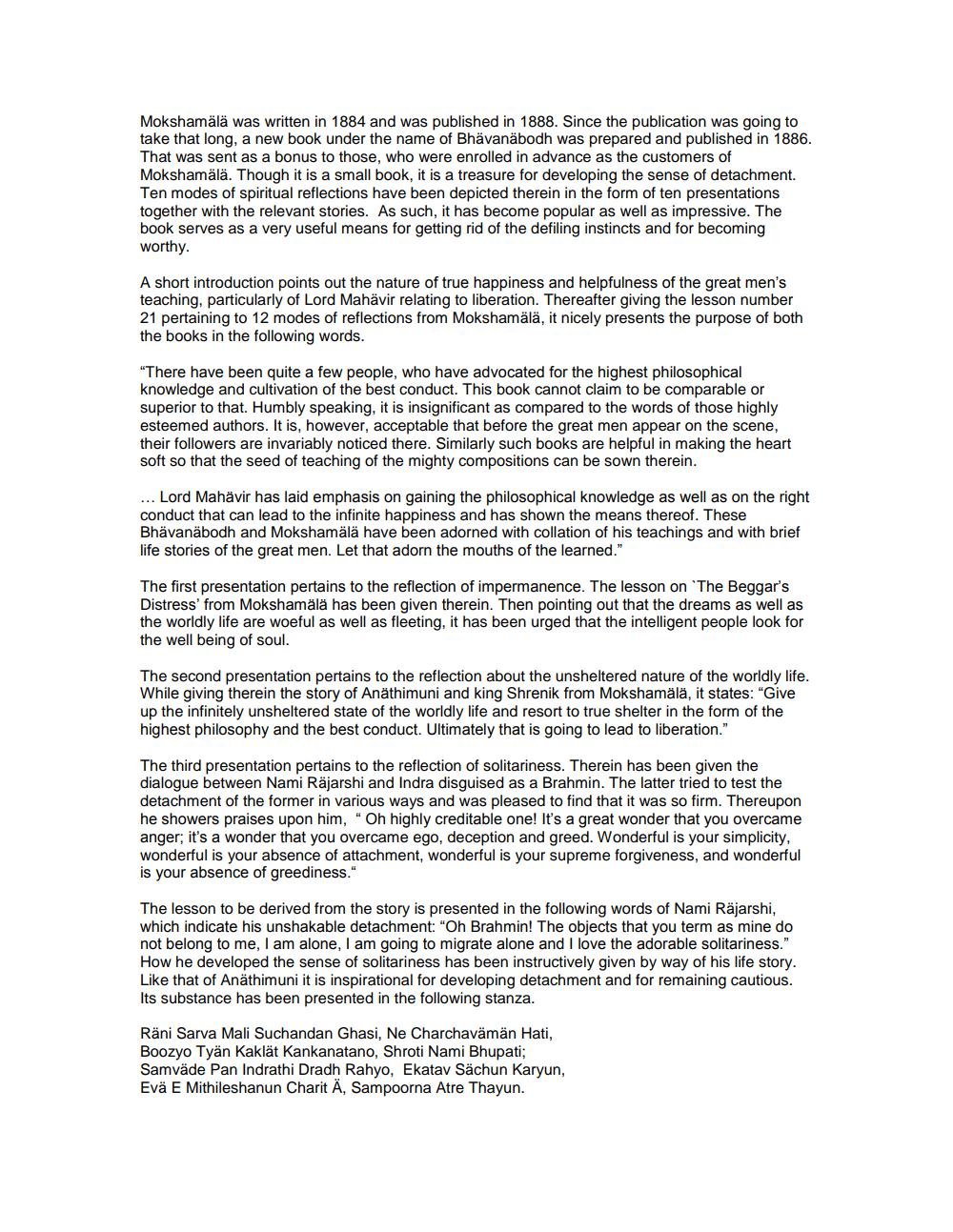________________
Mokshamälä was written in 1884 and was published in 1888. Since the publication was going to take that long, a new book under the name of Bhävanäbodh was prepared and published in 1886. That was sent as a bonus to those, who were enrolled in advance as the customers of Mokshamälä. Though it is a small book, it is a treasure for developing the sense of detachment. Ten modes of spiritual reflections have been depicted therein in the form of ten presentations together with the relevant stories. As such, it has become popular as well as impressive. The book serves as a very useful means for getting rid of the defiling instincts and for becoming worthy.
A short introduction points out the nature of true happiness and helpfulness of the great men's teaching, particularly of Lord Mahävir relating to liberation. Thereafter giving the lesson number 21 pertaining to 12 modes of reflections from Mokshamälä, it nicely presents the purpose of both the books in the following words.
"There have been quite a few people, who have advocated for the highest philosophical knowledge and cultivation of the best conduct. This book cannot claim to be comparable or superior to that. Humbly speaking, it is insignificant as compared to the words of those highly esteemed authors. It is, however, acceptable that before the great men appear on the scene, their followers are invariably noticed there. Similarly such books are helpful in making the heart soft so that the seed of teaching of the mighty compositions can be sown therein.
... Lord Mahävir has laid emphasis on gaining the philosophical knowledge as well as on the right conduct that can lead to the infinite happiness and has shown the means thereof. These Bhävanäbodh and Mokshamälä have been adorned with collation of his teachings and with brief life stories of the great men. Let that adorn the mouths of the learned."
The first presentation pertains to the reflection of impermanence. The lesson on 'The Beggar's Distress' from Mokshamälä has been given therein. Then pointing out that the dreams as well as the worldly life are woeful as well as fleeting, it has been urged that the intelligent people look for the well being of soul.
The second presentation pertains to the reflection about the unsheltered nature of the worldly life. While giving therein the story of Anäthimuni and king Shrenik from Mokshamälä, it states: "Give up the infinitely unsheltered state of the worldly life and resort to true shelter in the form of the highest philosophy and the best conduct. Ultimately that is going to lead to liberation."
The third presentation pertains to the reflection of solitariness. Therein has been given the dialogue between Nami Räjarshi and Indra disguised as a Brahmin. The latter tried to test the detachment of the former in various ways and was pleased to find that it was so firm. Thereupon he showers praises upon him, "Oh highly creditable one! It's a great wonder that you overcame anger; it's a wonder that you overcame ego, deception and greed. Wonderful is your simplicity, wonderful is your absence of attachment, wonderful is your supreme forgiveness, and wonderful is your absence of greediness."
The lesson to be derived from the story is presented in the following words of Nami Räjarshi, which indicate his unshakable detachment: "Oh Brahmin! The objects that you term as mine do not belong to me, I am alone, I am going to migrate alone and I love the adorable solitariness." How he developed the sense of solitariness has been instructively given by way of his life story. Like that of Anäthimuni it is inspirational for developing detachment and for remaining cautious. Its substance has been presented in the following stanza.
Räni Sarva Mali Suchandan Ghasi, Ne Charchavämän Hati, Boozyo Tyän kaklät Kankanatano, Shroti Nami Bhupati; Samväde Pan Indrathi Dradh Rahyo, Ekatav Sächun Karyun, Eva E Mithileshanun Charit Ä, Sampoorna Atre Thayun.




